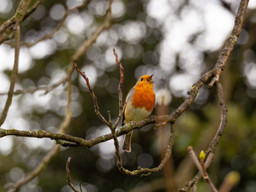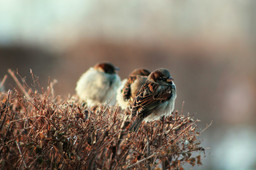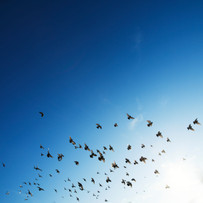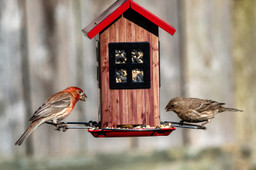
Everything you need to know about the dawn chorus
It can be all too easy to take the natural world around us – or its vestiges – for granted. The dawn chorus is such a familiar concept that it can be dismissed without any thought. That would be a tragic oversight – yet how many of us have truly made the effort to listen to it? To get up before the sun rises in order to appreciate it? Here, we provide a curtain-raiser which we hope may persuade you to do just that.
Read on for answers to all your questions about the dawn chorus: why does it happen? How does it relate to the dusk chorus? Do birds vocalize because they enjoy it? And how do they sing like that, anyway? Is the chorus growing or diminishing? And what can we all do to help support our local birds?
But, first things first:
What is the dawn chorus?
First used as recently as the 1920s, this phrase refers to the songbird vocalizations which occur before, during, and after the sunrise. Different songbird species (which constitute “more than half of the world’s bird species”) may commence singing at slightly different times, partly on the basis of the height of their perches, as the highest are able to perceive the dawn light sooner.
Birdsong in general is understood to relate to identification, attracting mates, demonstrating fitness, and defending territory and paternity rights. However, the reason why birds sing with particular vigor in the early morning is not yet understood. It has been theorized that the chorus provides “a roll call of occupied territories, allowing any absentees to be noted and their space to be invaded”; individuals hoping to secure territory for themselves are therefore likely to be especially active at first light, when there is sufficient visibility to get around but not yet to forage. Also, given the large amount of energy required, singing is a way to demonstrate an individual’s health and stamina – especially after a night during which it has been too dark to feed. In this way, singers can prove their suitability as a mate.

In addition, this time of day is characterized by reductions in wind and air turbulence, meaning that sound can be transmitted with particular effectiveness – in fact, “up to 20 times more effective[ly] than at noon”. Once the sun has fully risen, diurnal birds will be preoccupied with finding food. As singing risks attracting predators’ attention, it is perhaps also preferable to serenade before daylight makes the singers easier to locate.
It has typically been thought that it is overwhelmingly male birds which sing, with females only able to call. Contemporary research has shown otherwise; in 2016, 64% of the females from more than 1,000 songbird species were found to sing. However, females’ songs are usually quieter and more infrequent, making them easier to overlook. Evidence also shows that male researchers within ornithology are less likely to study female birdsong than their female counterparts; given that the discipline (along with natural history in general) has been historically male-dominated, this has created a skewed understanding of bird behavior.
What adaptations enable birdsong?
The calls which are so audible during the dawn chorus are the product of birds’ syrinx, a structure similar to our larynx. However, where the human larynx is located in the throat, the syrinx is positioned much closer to the lungs, allowing a larger proportion of oxygen to be used to generate sound more efficiently. The variety of birds’ calls, meanwhile, is enabled by a wide range of variation within the physiology of their syrinx and trachea.
Given the significance which vocalization has for birds, it’s unsurprising that their hearing is appropriately acute. Tiny hair cells which transmit sound from mammals’ ears to their brains decline with age; birds, on the other hand, do not have to contend with this increasing deafness, as these cells regenerate throughout their lives, maintaining consistently strong hearing.
But where do birds’ songs come from? The calls of both songbirds and non-songbirds are innate, but singing birds “inherit a ‘template’” for their songs. It is only by listening to other individuals singing that they are able to learn their species’ complete song.

The more unwelcome question may be whether birds sing for the sheer joy of being alive. Humanity has adopted nakedly positive connotations for birdsong. The actual functionality of birdsong may be disappointingly unromantic; singing, for birds, is a matter of survival. “If singing were solely an expression of joy”, birds would do it whenever they felt moved to – yet this is not the case: it occurs primarily during the breeding season, and at certain times of day. However, this of course in no way negates the enjoyment we derive from it.
And what about the dusk chorus?
Birds do also chorus at sundown, but it’s generally considered less audible – “more chamber ensemble than symphony orchestra” – though this may be because it is simply less noticeable to us, when we aren’t trying to make the most of still being in bed. However, certain species – notably, blue tits and tree sparrows – have a preference for singing at this time of day, rather than in the morning. And finding time to listen to the dusk performance may be a more viable option for people who struggle to get up early.
Where can I hear the dawn chorus?
The UK’s Royal Society for the Protection of Birds (RSPB) suggests that the end of April to the beginning of June is the ideal period, particularly on clear days with minimal wind. The RSPB also provides an instructive ‘ID playlist’, a selection of recordings to help identify common species in the UK by their calls (the blackcap’s is particularly lovely) – while their bird-identifier helps would-be twitchers to decipher what species they’re looking at, narrowing the options down by criteria including location, size, color, and behavior.
In countries which experience temperate climates – those in the middle latitudes above and below the equator, which are subject to distinct seasonal variations – the dawn chorus is most noticeable during the spring and early summer, since “songbirds time their breeding season to the warmest part of the year, when there is plenty of food and lots of daylight in which to find it”. Different species lay their eggs at different rates throughout this period, while the increased length of day at this time “triggers a hormonal change in birds that enlarges the parts of the brain controlling song production”.
In the same way that laying times relate to external circumstances, even the sequence in which different species start to call in the morning is broadly preordained: robins, skylarks, song thrushes, and blackbirds are among the earliest to begin singing, while warblers and wrens, for example, only join in later. Since these species are smaller, it could be that they are more sensitive to the early morning chill, while their insect prey is also yet to appear at that time.

As for location: the greener the better. Countryside, nature reserves, woods, and parks – areas which can support large and diverse populations – will naturally host the most impressive recitals. However, anywhere with some trees and shrubs is likely to support enough birdlife to give a taste of the avian matins.
More specifically, different habitats cater to different species. In an urban setting, you may expect to hear house sparrows, pigeons, and blackbirds; in woodland, redstarts, song thrushes, and robins will be more likely. In wetlands, listen out for sedge warblers, reed buntings, and bitterns, while moorlands may give you an opportunity to hear curlews, skylarks, and golden plovers.
What is International Dawn Chorus Day?
Originally organized by the Wildlife Trust for Birmingham and the Black Country (then known as the Urban Wildlife Group), International Dawn Chorus Day is held annually on the first Sunday of May. Having grown from a small Birmingham-based event to one which involves participants from over 80 countries, members of the global public are encouraged to join events at appropriate locations on this day, in order “to revel in the sweet sound of birdsong, from rattling wrens in Rotherham to crooning cowbirds in the Caribbean”.
‘Embrace the Dawn Chorus’, an article on the Wildlife Trusts’ website, helps to evoke the sort of experience that the early birds among us (sorry) may experience: “It’s never easy to escape the warmth of your bed in the early morning, but the dawn chorus has to be experienced to be believed. Just a snatch of birdsong is enough to rouse a smile and create a connection to the wild world around us, even in the heart of urban areas. During the dawn chorus, this soul-stirring sound washes over you from every direction.”
Similarly, author and journalist Simon Barnes, writing in his book Rewild Yourself, describes the chorus as the “single biggest wildlife miracle that we have in Britain” – though this description shouldn’t be confined to the British Isles alone.
Why is the dawn chorus declining?
The contemporary dawn chorus is “quieter and less acoustically diverse” than in the past. Is it really any surprise to say that we are the cause of this? Since 1970, according to research by the British Trust for Ornithology (BTO), the amount of wild birds in Britain has declined by a staggering 73 million – almost a third of the total at that time. Today, there are 30 million fewer house sparrows in the country, 20 million fewer starlings, four million fewer skylarks, two million fewer blackbirds, and one million fewer chaffinches.
The majority of the species in decline are farmland birds, a habitat “where a mix of increasingly industrialised agriculture, habitat loss and the climate crisis are having severe impacts”. Destruction of hedgerows and flower meadows and increased use of pesticides means that these losses can nevertheless be felt all over the country. The BTO has created a website, Birds on Your Doorstep, which is searchable by postcode, and which shows the species lost from any given area over the last 50-plus years. As the organization’s Chief Executive, Professor Juliet Vickery, explains, “Presenting these results at the local level […] delivers a powerful message that the UK’s birds are in trouble, and that we all need to do more.”
However, the statistics don’t tell the full story: 48% of all UK bird species declined between 2015 and 2020 (during which time, woodland birds suffered the worst losses, despite farmland birds having declined the most overall). The drop of 73 million birds since 1970 “is [also] masked by an increase of some 41 million birds from certain species such as wrens, wood pigeons and blackcaps”; as such, the loss of individual birds is closer to 114 million.
How can I support birdlife?
There are many simple actions which we can take in order to support local birdlife (and which don’t necessarily require a garden).
The Berkshire, Buckinghamshire and Oxfordshire Wildlife Trust (BBOWT) and RSPB have both prepared a range of helpful guides, including:
- How to feed birds year round (including five main food types and five ways to provide them, general tips, and a reminder to provide clean water) 🦅
- How to build bird boxes and swift boxes (including recommendations for ideal location; also consider building swift bricks into extensions), and how to support nesting on and around roofs
- How to clean boxes and feeders annually, to ensure that the birds stay healthy
- How to make a bird bath (and where to position it) 💦
- What to do if you find an injured or a chick
- What to do in case of disease.

Now that the already embattled UK bird populations are facing “the worst outbreak of [avian flu] ever seen in the UK”, it is particularly vital that we support them. This is particularly true given our culpability in the outbreak, which “is believed to have its origins in the epidemic that has affected poultry farms and other captive birds over the last year”; captive birds in close contact form an ideal breeding ground for difficult-to-contain viruses.
Does earth.fm feature any recordings of dawn choruses?
🎧 While it doesn’t compare to experiencing the real thing, a number of recordings are available on earth.fm; this playlist was prepared to celebrate International Dawn Chorus Day, and features soundscapes from habitats such as grassland, rainforest, mountains, deserts, and wetland, from countries as varied as Estonia, Bolivia, Senegal, Australia, Ireland, and Denmark.
We hope that by listening to the magical birdsong contained in more than 20 hours of soundscapes (with some marsh frogs thrown in for good measure), your appreciation of the birdlife may be increased – perhaps you’ll feel moved to start feeding the local birds, or knock up a bird house at the weekend.
Happy listening!
Featured photo by Trevor McKinnon on Unsplash
Earth.fm is a completely free streaming service of 1000+ nature sounds from around the world, offering natural soundscapes and guided meditations for people who wish to listen to nature, relax, and become more connected. Launched in 2022, Earth.fm is a non-profit and a 1% for the Planet Environmental Partner.
Check out our recordings of nature ambience from sound recordists and artists spanning the globe, our thematic playlists of immersive soundscapes and our Wind Is the Original Radio podcast.
You can join the Earth.fm family by signing up for our newsletter of weekly inspiration for your precious ears, or become a member to enjoy the extra Earth.fm features and goodies and support us on our mission.
Subscription fees contribute to growing our library of authentic nature sounds, research into topics like noise pollution and the connection between nature and mental wellbeing, as well as funding grants that support emerging nature sound recordists from underprivileged communities.

